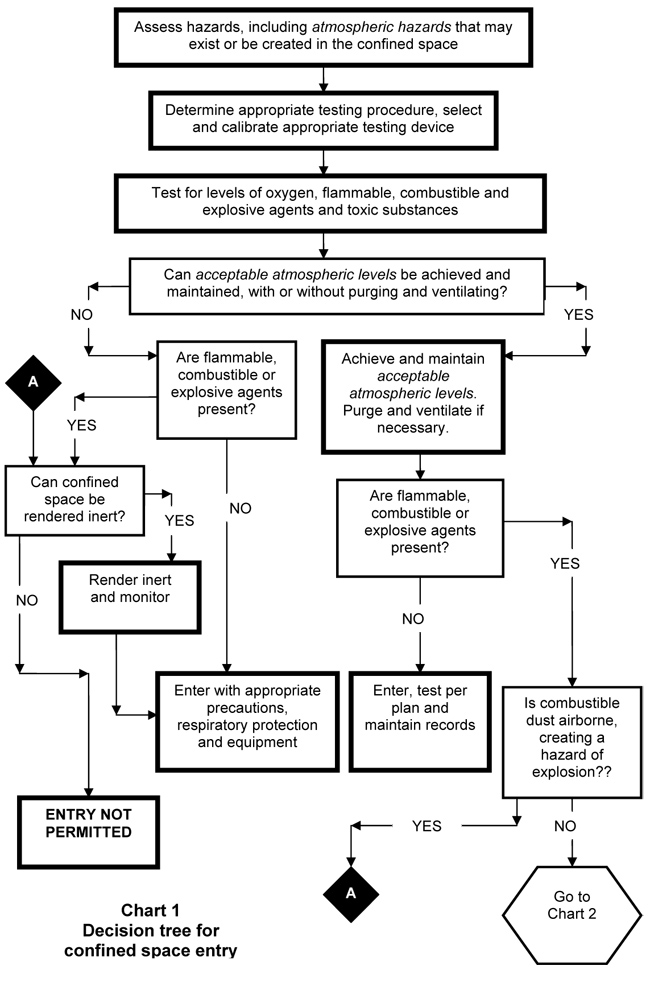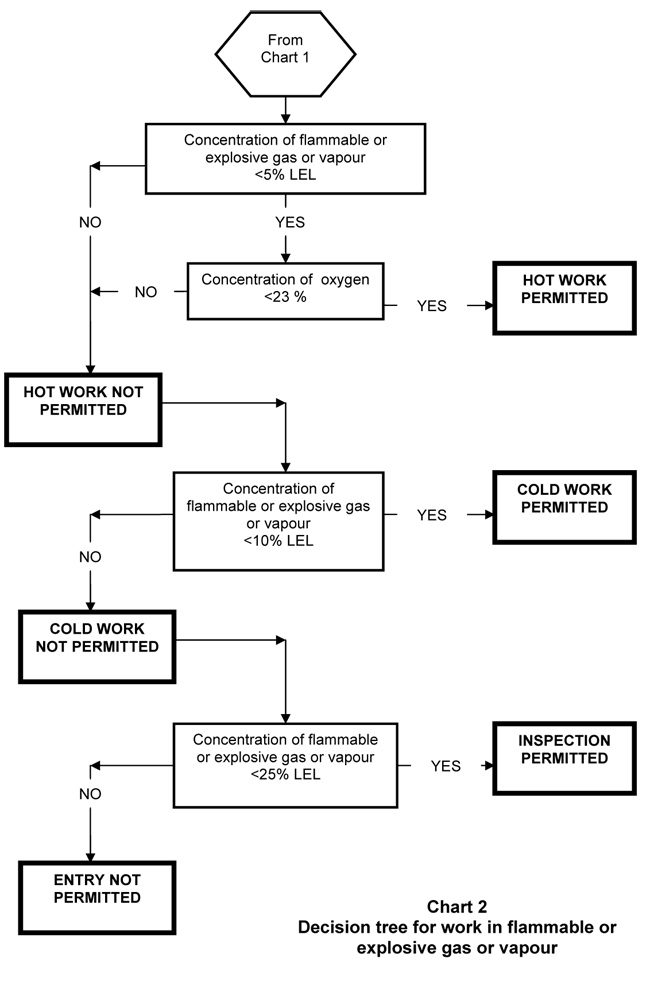We've moved this content over from an older government website. We'll align this page with the ontario.ca style guide in future updates.
Atmospheric testing
Section 18 - Confined Spaces Regulation (O. Reg. 632/05)
18 (1) The employer shall appoint a person with adequate knowledge, training and experience to perform adequate tests as often as necessary before and while a worker is in a confined space to ensure that acceptable atmospheric levels are maintained in the confined space in accordance with the relevant plan.
(2) If the confined space has been both unoccupied and unattended, tests shall be performed before a worker enters or re-enters.
(3) The person performing the tests shall use calibrated instruments that are in good working order and are appropriate for the hazards identified in the relevant assessment.
(4) The employer shall ensure that the results of every sample of a test are recorded, subject to subsection (5).
(5) If the tests are performed using continuous monitoring, the employer shall ensure that test results are recorded at adequate intervals.
(6) The tests shall be performed in a manner that does not endanger the health or safety of the person performing them.
(7) In this section,
- “sample” means an individual reading of the composition of the atmosphere in the confined space
- “test” means a collection of samples
(Refer to the flow charts on Atmospheric Hazards at the end of this Section)
When is it necessary to conduct atmospheric testing?
The plan must contain provisions for atmospheric testing. The testing must be done as often as necessary before and while a worker is in a confined space. The atmospheric hazards of concern include oxygen content outside the acceptable range of 19.5 to 23%, the potential accumulation of flammable, combustible, or explosive agents, or accumulation of atmospheric contaminants.
Who is responsible for performing atmospheric testing and for what reasons?
The employer must appoint a person with adequate knowledge, training and experience to perform adequate tests. The testing is required as often as necessary before and while a worker is in a confined space to ensure that acceptable atmospheric levels are maintained in the confined space in accordance with the relevant plan.
What are some of the requirements of atmospheric testing?
Representative sampling should take into consideration the presence of stratified atmospheres and pockets of contaminated air within the confined space. The selection of testing equipment will depend on the circumstances of the confined space, the nature of the work within the space, and knowledge of possible atmospheric hazards. Whenever practical, continuous monitoring should be considered. Equipment performance characteristics to be considered include, but are not limited to: principle of detection of the hazards of concern, specificity, interferences, detection concentration range, response time, calibration requirements, and intrinsically safe equipment for spaces with potential accumulation of flammable hazards.
All workers involved with confined space entry should be trained to understand the testing results, in accordance with the relevant plan.
What is meant by "calibrated instruments that are in good working order and are appropriate for the hazards identified in the relevant assessment"?
Instruments used for measuring atmospheric hazards should be calibrated as per manufacturers' requirements. The testing instrument must be selected and calibrated for the specific atmospheric hazards likely to be present in the space as identified in the relevant assessment. Equipment maintenance and calibration records should be kept.
May I use general survey instruments for atmospheric testing?
Yes, but for general survey instruments with sensors that respond to many different chemicals with similar properties, the person performing the tests and the users of test results need to understand the specificity and relative response characteristics of the instrument for proper interpretation of results. For example, a combustible gas instrument that uses pentane as the calibration gas will measure other combustible gases such as methane with a different response characteristic. In this case, the actual concentration of methane will be determined by applying a correction factor to the readout of the instrument.
When the exposure is to an unknown mixture of atmospheric contaminants or combustible gases, the testing results need to be interpreted by a person with adequate knowledge, training and experience about the confined space hazards of concern and the testing equipment.
When is continuous monitoring required?
Continuous monitoring is required:
- when performing hot work in a confined space that contains or is likely to contain an explosive or flammable gas or vapour.
- when the atmosphere in the confined space has been rendered inert by adding an inert gas, or
- as set out in the confined space plan.
When using continuous monitoring equipment, which may have data logging capability, are records required for test results?
Even though a continuous monitor may have data logging capability, results must still be recorded at adequate intervals as determined by the plan, above and beyond the data logging printout or electronic storage. This ensures that workers are actually aware of the levels they are encountering and aware of any fluctuation that may be occurring in order to warn them of any unusual conditions as they develop. Monitors may have alarms; however, depending at what level they are set, they may not give the workers adequate warning of fluctuations or increases in atmospheric levels that should be investigated.
What is the required frequency for recording atmospheric test results?
The frequency of recording test results is determined by the confined space plan, based on the potential for accumulation and possible fluctuations of the atmospheric hazards as determined by the assessment.
What are the requirements for record keeping?
In general, the employer must retain atmospheric testing records for the longer of the following periods: one year after the document is created; or, the period that is necessary to ensure that at least the two most recent records of each kind that relate to a particular confined space are retained. For confined spaces with multi-employer involvement, the constructor or employer (as the case may be) responsible for creating the record shall retain the record. On construction projects, the records must be kept by the constructor or employer (as the case may be) for at least one year after the project is finished.
Atmospheric hazards and atmospheric testing
Chart 1 – Decision tree for confined space entry

- Assess hazards, including atmospheric hazards that may exist or be created in the confined space.
- Determine appropriate testing procedure, select, and calibrate appropriate testing device.
- Test for levels of oxygen, flammable, combustible and explosive agents and toxic substances
- Can acceptable atmospheric levels be achieved and maintained, with or without purging and ventilating?
- If yes, go to step 5.
- If no, go to step 7.
- Achieve and maintain acceptable atmospheric levels. Purge and ventilate if necessary. Are flammable, combustible, or explosive agents present?
- If yes, go to step 6.
- If no, enter, test per plan, and maintain records.
- Is combustible dust airborne, creating a hazard of explosion?
- If yes, go to step 8.
- If no, go the chart 2.
- Are flammable, combustible, or explosive agents present?
- If yes, go to step 8.
- If no, enter with appropriate precautions, respiratory protection, and equipment.
- Can confined space be rendered inert?
- If yes, render inert and monitor. Enter with appropriate precautions, respiratory protection, and equipment.
- If no, entry not permitted.
Chart 2 – Decision tree for work in flammable or explosive gas or vapour

- Is the concentration of flammable or explosive gas or vapour less than 5% LEL?
- If yes, go to step 2.
- If no, go to step 3.
- Is the concentration of oxygen less than 23% LEL?
- If yes, hot work is permitted.
- If no, go to step 3.
- Hot work is not permitted. Is the concentration of flammable or explosive gas or vapour less than 10% LEL?
- If yes, cold work is permitted.
- If no, go to step 4.
- Cold work is not permitted. Is the concentration of flammable or explosive gas or vapour less than 25% LEL?
- If yes, inspection permitted.
- If no, entry is not permitted.